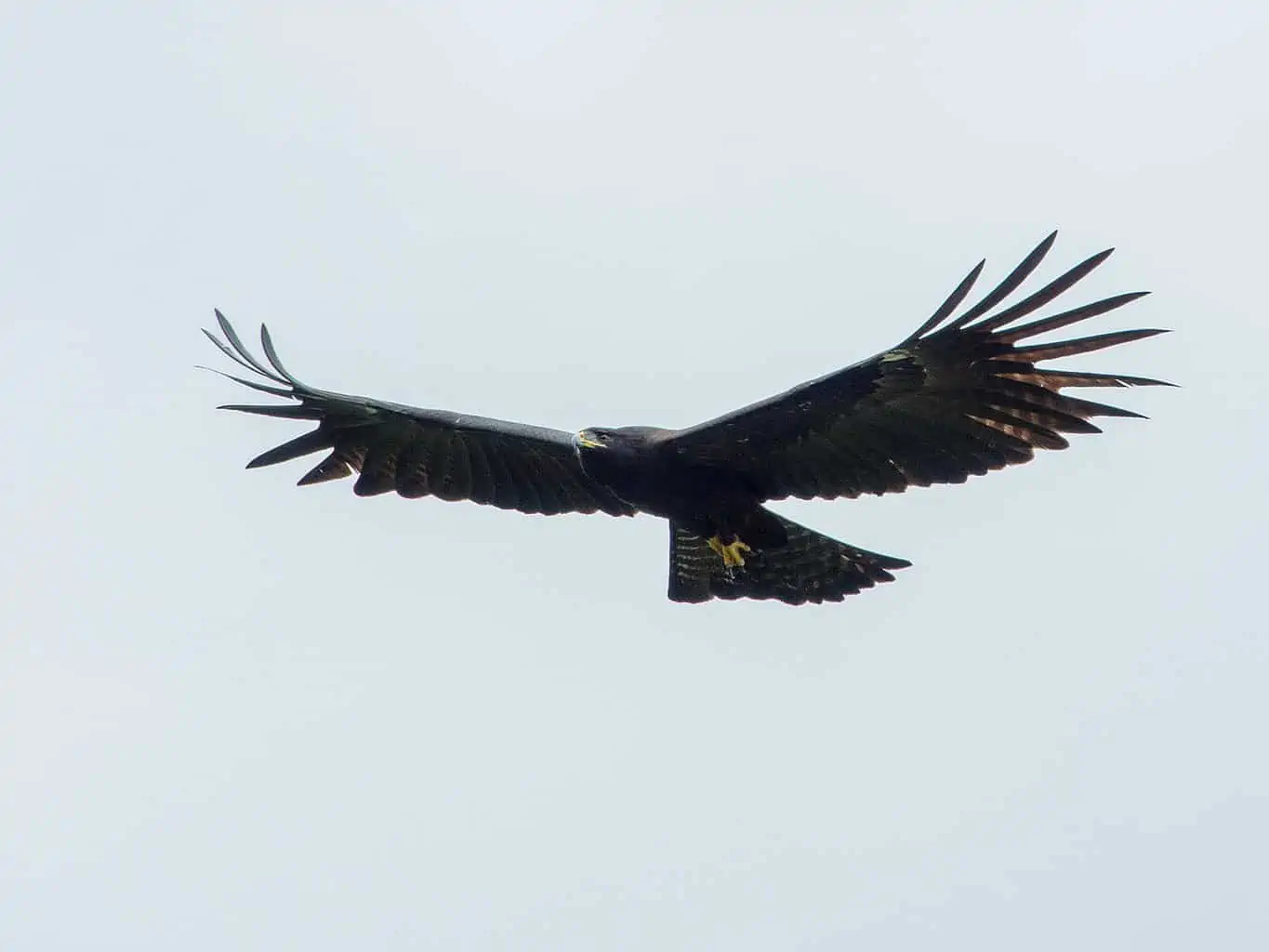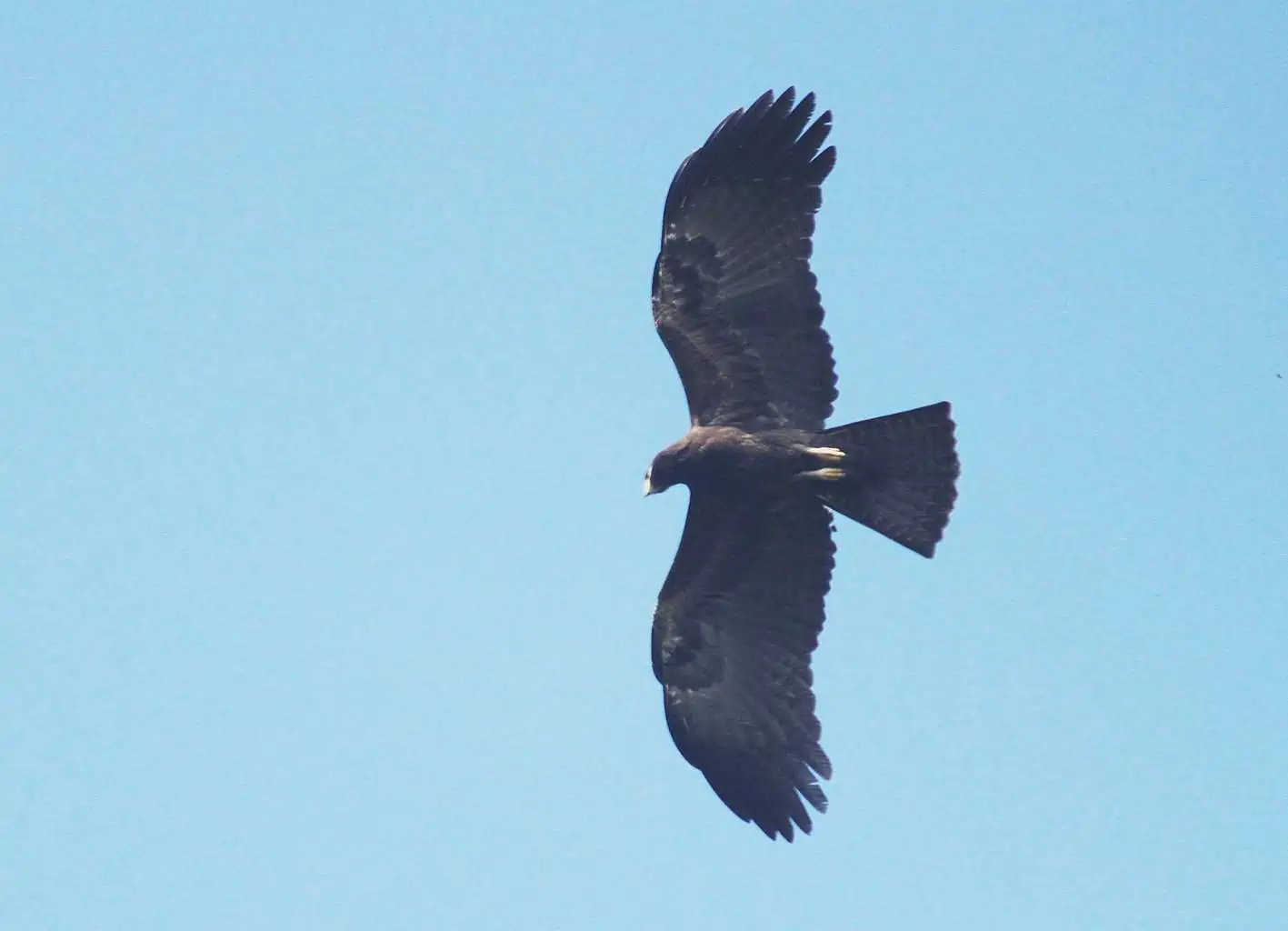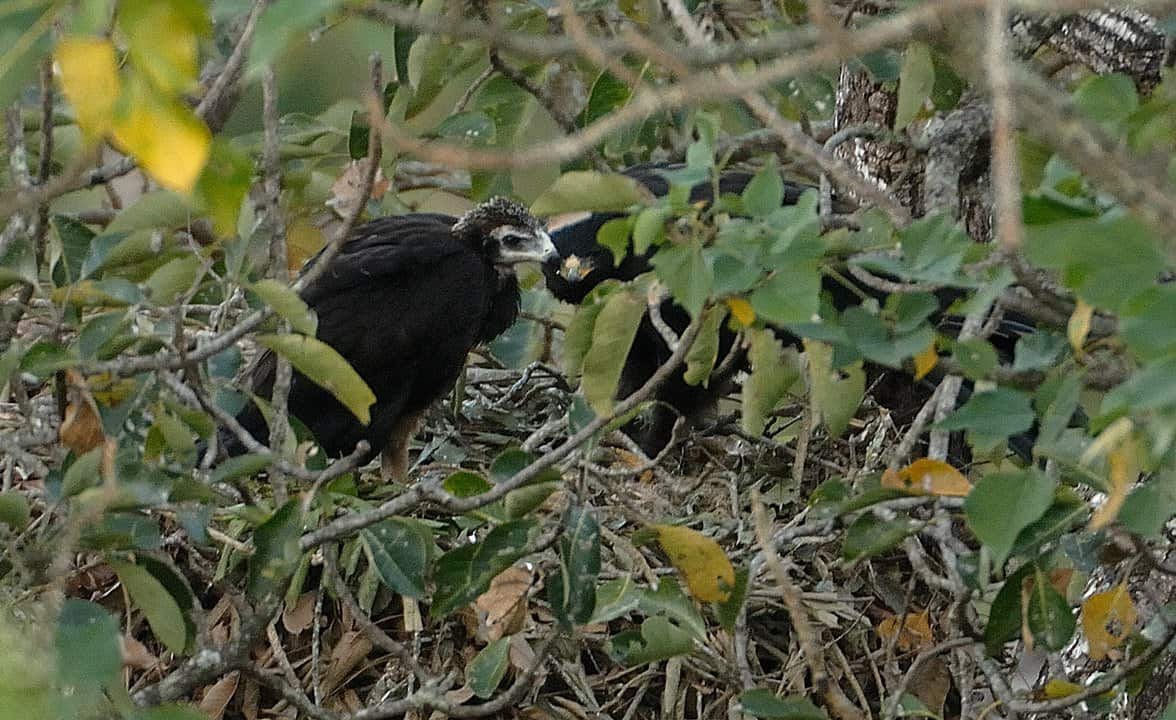- Amethyst-throated Mountain-Gem Guide (Lampornis amethystinus) - November 24, 2022
- Best Martin Bird House Guide - November 14, 2022
- Best Millet Bird Seed Guide - November 9, 2022
As if eagles didn’t already look like murder machines soaring through the sky, in flies the Black Eagle. A jet black bird that soars low and slow as it scans over subtropical forests and mountain ranges. Strongly contrasting against a blue sky, the Black Eagle is seen with its massive outstretched wingspan. At first glance, you might first mistake this bird for a vulture. Upon taking a closer look with your binoculars, you’ll notice the fine details that emit elegance, grace, and ferocity.
Not to be confused with the Black Hawk eagle (Spizaetus tyrannus) or Verreaux’s Eagle (Aquila verreauxii), the Black Eagle is a member of the order Accipitriformes and belongs to the family Accipitridae. This family is known for their dangerously fierce hooked bills. The Black Eagle’s genus, ictinaetus, is also part of the subfamily Aquilinae. This subfamily comprises booted eagles, such as spotted eagles, martial eagles, crowned eagles, and rufous-bellied eagles. Confusingly enough, the Black Hawk-eagle is also a member of this subfamily but is commonly called the Tyrant Hawk-eagle. Booted eagles are known for their feather-covered legs or tarsi, a trait that is easily seen in the Black Eagle.
Unfortunately, there is not a wealth of information readily available about the Black Eagle, partly due to its remote range across southeastern India. Still, this guide compiles a healthy amount of knowledge to understand the Black Eagles’ life thoroughly.
How to Identify a Black Eagle
Well, they got their name for a reason, so I bet you already know what color this spectacularly fierce eagle is. Why yes, it’s black! Brilliant black feathers adorn this bird’s entire body. The only contrasting color is its yellow feet and cere. Its tail, primaries, and secondaries feature subtle beige barring. This is mostly observed when in flight. When wings are outstretched, this bird’s feathers flair outwards like fingers. These are also known as emarginated primaries. Emarginated primaries aid birds in low-level and low-energy flight.
These large birds are about 30 inches in length with a wingspan ranging from four to six feet. That fact alone gives me, a five-foot-tall human, a healthy amount of fear. You might expect that a bird of such great size would have the weight to match, but on average, the Black Eagle is only two to three and a half pounds. Still, I’m not going to attempt to befriend one.
Males and females have similar appearances. Juveniles can be differentiated by their buffy heads and underparts.
Where Does a Black Eagle Live: Habitat
Black Eagles live in forested mountainous and subtropical areas of Asia. This majestic bird is found across the foothills of the Himalayas, Sri Lanka, Bangladesh, Thailand, Malaysia, Indonesia, and Taiwan. This species is non-migratory, and studies show that their preferred area is in southern India due to its dense forests.
Since dense forests are their favored areas, it might be hard to spot one. If you head into the mountains to get a bird’s eye view, you’ll have a better chance of seeing this powerful bird.
Black Eagle Diet and Feeding
A healthy diet of small mammals fuels Black Eagles year-round. It uses slow flight techniques as it scans the forest for movement. The Black Eagle is particularly keen on swiping eggs that have been left, albeit briefly, in unattended nests. Additionally, they may even take the entire nest, chicks and all, to their dining room table. Yikes, that’s a short-lived life. Once their desired food has been located, the Black Eagle uses its large claws to snatch and clutch prey, carrying it away to a safe feeding perch.
The Black Eagle is an apex predator in its range. As the Black Eagle soars over forests, rivers, streams, creeks, and open territory, animals of every kind become alarmed and try to tell other nearby animals that this predator is nearby.
Indian giant squirrels are particularly popular prey, along with other squirrels, bats, rats, mice, and a variety of reptiles and insects. Other tropical-dwelling mammals like bonnet macaques and the Indian giant squirrel have also been indicated as top prey species.
The Black Eagle is classified within the family Accipitridae, which is one of the three families within the order Accipitriformes. Accipitridae is known for its intensely hooked bills. These bills aid eagles in ripping flesh while their powerful tarsi make first contact with prey. Diets are commonly supplemented with carrion or decaying flesh.
While these powerful bills are certainly intimidating, their strong talons allow the bird to deliver a quick blow to their prey. If they do not kill their prey on contact, they will usually use their talons to puncture the animal further. These razor-sharp talons allow eagles to kill prey that might be too large for them to carry. This can be a good tactic that allows the bird to stockpile or cache food, or it could attract scavengers that will steal meat. Food is primarily cached during breeding season when there are more mouths to feed.
Black Eagle Breeding
What’s cooler than one Black Eagle? Two in courtship! While I’ve never had the opportunity to spot a Black Eagle, watching accipitrids do their courtship dance and dives is a very magical thing to witness.
Larger eagles, such as the Black Eagle, reach sexual maturity between ages one to nine. As these birds mature and return to breed, they may choose their own natal site as prime territory.
The courtship process between Black Eagles involves steep climbing into the sky, followed by deep “U” shaped dives. The two birds will also chase each other across a forest. That’s one idea for a cheap date!
Once impressive displays and cheap dates are over, the pair typically mate for life. Black Eagles in southern India breed from November to March, while those located in other areas may breed from April to August.
Black Eagle Nesting
Pairs work together to defend their nesting territory. Nests are located in tall trees with surrounding views of incoming threats and prey. The pair will build serval nests that are maintained and used in subsequent years. To build the nests, the pair works together. Males are responsible for collecting materials, while females work to create a large platform that is 3 to 4 feet wide.
The nests of Accipitrids also contain a variety of cushiony materials to make the nest comfortable. Materials like bark, green leaves, and conifer needles differentiate these nests from the nesting sites of falcons.
Black Eagle Eggs
Once nests are built, males begin to regularly provide food for females in anticipation of laying eggs. Males also provide the bulk of the food during the incubation and nesting process. Clutch sizes range from one to two white eggs that may have cinnamon-colored spotting. Larger species of eagles must incubate eggs longer, and although no immediate data regarding incubation length is available on Black Eagles, incubation periods likely range from 43 to 47 days.
Incubation is a shared responsibility for most members of Accipitridae, and the male and females rotate in shifts. Once the eagles reach 84 to 99 days old, feathers will begin to show. After the initial fledging, the birds will remain near the nest to receive assistance from their parents before truly taking off on their own. This period of dependence may last for a year before mom and dad say enough is enough.
Black Eagle Population
The Black Eagle is not a threatened species but is not extremely common in its range. According to BirdLife International, the population is decreasing but is listed as a species of low concern. Global population numbers are estimated to be around 10,000 individuals.
Threats to the forests in which they live are the main factors causing a declining population.
Black Eagle Predators
As is often the case with large birds of prey (their name really gives this bit away, huh?), predators are rarely present. Black Eagles do not have many natural predators, but when it comes to nest raiding, there are a few that this militant bird must stay vigilant against.
Nest raiding is a form of predation that many species of birds are susceptible to. This can be performed by mammals, reptiles, or other birds. The go-to predators are raccoons, cats, snakes, squirrels, chipmunks, and bears in some areas. Other very common nest raiders are other birds. In tropical areas, small primates are also very common bandits.
Much like the Black Eagle is a prime nest raider in its range, other birds like hawks, eagles, owls, and corvids may also attempt a skillful attack on eggs and nestlings. Black Eagles are no match for most nest raiders, quickly turning any “predator” into prey.
Black Eagle Lifespan
Most eagles have an average lifespan of 20 to 30 years, but in captivity, they can live upwards of 40 or 50 years.
Black Eagle Facts
- The Black Eagle is featured on the coat of arms for Germany.
- This bird is meant to symbolize immortality, foresight, and courage.
- The Black Eagle may also be referred to as the Indian Black Eagle.
- It was previously classified within the genus Falco.
- The Black Eagle may be easily confused with Verreaux’s Eagle of Africa.
Easily Confused: African Black Eagle and The Indian Black Eagle
These two birds can be easily mistaken for one another, and although their ranges do not overlap, their extreme similarities in appearance and name make them a prime target for confusion while performing any kind of research on the species. If you give “Black Eagle” a quick Google, you’ll receive a wide array of information, mostly about the African Black Eagle, formally known as Verreaux’s Eagle. Becoming familiar with species’ scientific names is a great way to ensure you are reading about your intended subject. I also find it most helpful to understand any nicknames and the range of look-alikes or commonly confused birds.
- Verreaux’s Eagle (Aquila verreauxii)
- Black Eagle (Ictinaetus malaiensis)
FAQs About Black Eagles
Answer: While the population numbers do not indicate the species is threatened, Black Eagles are not very common to sight on your average Tuesday. If you see one, consider yourself lucky and stay in the moment as you watch this elegant eagle.
Answer: Well, for starters, one look at these stunning birds is enough to know they are a special species. They are part of the “booted eagles” subfamily, so you’ll notice that they have feathers covering their legs. In addition to being showstoppers, they are fierce predators that are known for carrying away entire nests of other birds’ young. Yikes!
Answer: Throughout various Indian cultures across southeastern and southern Asia, the Black Eagle is a mysterious god-like figure that is known to symbolize rebirth, protection, and illusions.
Answer: There are a few species that are easy to mix up with Ictinaetus malaiensis. The first of which is the Verreaux’s Eagle. Verreaux’s Eagle is found across Africa and western Asia. Verreaux’s Eagle may be referred to as the African Black Eagle, while Ictinaetus malayensis is referred to as the Indian Black Eagle.
Research Citations
Looking for more interesting readings? Check out:





